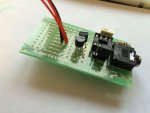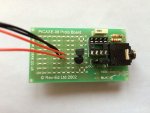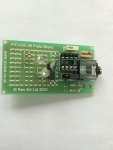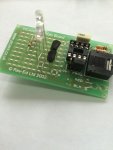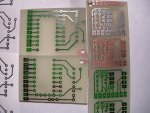WHITEKNUCKLES
New Member
The numbers in this subroutine give about 90 cycles per minute on pin0 and pin1 while pin2 Flickers continuously.
It uses 37 bytes so on this SM 08M there is the possibility of having 5 such subroutines with altered numbers and possibly room for a random routine to select them.
Note the 'return' is commented out and a 'goto aa' added.
It has been copied and pasted into the Programming Editor, downloaded into a 08 Proto Board and is running continuously.
If FETs were mounted in the first/second row of holes the third row could have standard 0.1 inch header pins and the rest of the Proto Board cut off to save almost an inch in length.
So this might all you need. Easy soldering and easy download but change the pins so that you would not be bothered fiddling with the jumper on pin0.
Using an 08M2 would mean that such a variety of routines could make a contiguous program taking so much time to run that it is doubtful if anyone could recognise the repetition.
Dave
https://www.fairchildsemi.com/datasheets/2N/2N7000.pdf
aa:
for b4=1 to 8 ' ...........Number of times sequence is repeated
high 0
low 1
for b6 = 1 to 8 ' ........Timing of Flash instead of a pause
toggle 2
pause 44'..................Time for Flicker to be visible
next b6
low 0 '....................Alternate colour of Flash
high 1
for b6 = 1 to 4
toggle 2
pause 44
next b6
next b4
'return
goto aa
It uses 37 bytes so on this SM 08M there is the possibility of having 5 such subroutines with altered numbers and possibly room for a random routine to select them.
Note the 'return' is commented out and a 'goto aa' added.
It has been copied and pasted into the Programming Editor, downloaded into a 08 Proto Board and is running continuously.
If FETs were mounted in the first/second row of holes the third row could have standard 0.1 inch header pins and the rest of the Proto Board cut off to save almost an inch in length.
So this might all you need. Easy soldering and easy download but change the pins so that you would not be bothered fiddling with the jumper on pin0.
Using an 08M2 would mean that such a variety of routines could make a contiguous program taking so much time to run that it is doubtful if anyone could recognise the repetition.
Dave
https://www.fairchildsemi.com/datasheets/2N/2N7000.pdf
aa:
for b4=1 to 8 ' ...........Number of times sequence is repeated
high 0
low 1
for b6 = 1 to 8 ' ........Timing of Flash instead of a pause
toggle 2
pause 44'..................Time for Flicker to be visible
next b6
low 0 '....................Alternate colour of Flash
high 1
for b6 = 1 to 4
toggle 2
pause 44
next b6
next b4
'return
goto aa
Last edited:

